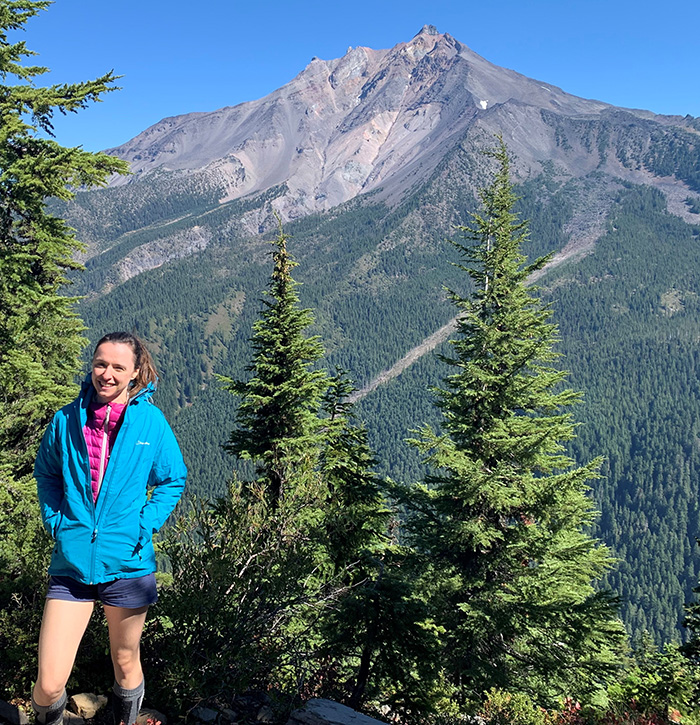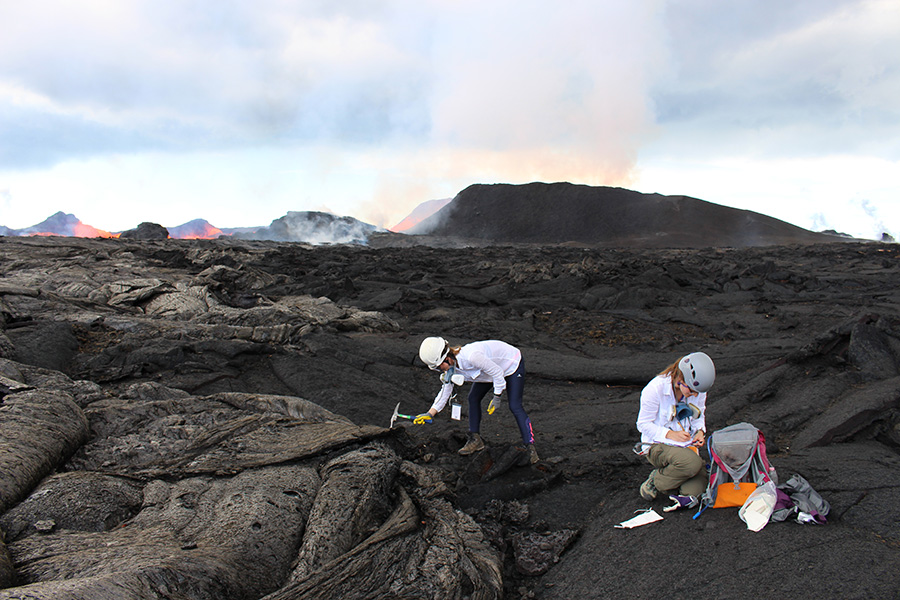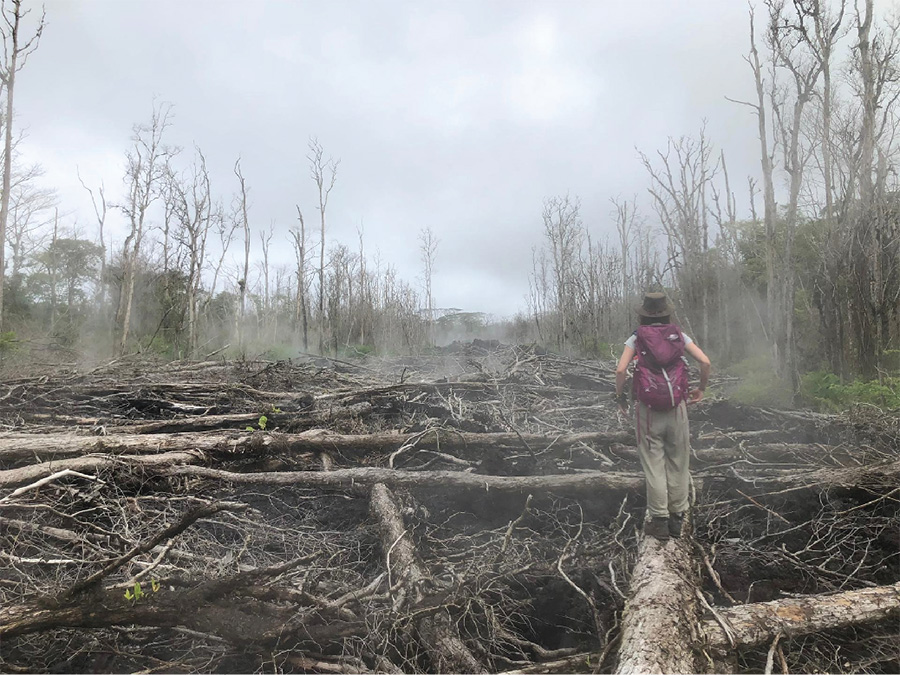New Tools to Visualize the Insides of Volcanos
Penny Wieser, a 2022 Rose Hills Innovator, is developing a new approach to study the magma stored deep beneath a volcano.
In 2018, an earthquake shook the ground under Kilauea, the most active volcano in the Hawaiian Islands. Lava began flowing— slowly at first and then more forcefully— down Kilauea’s ocean-facing slope, destroying hundreds of homes in the process.
Within weeks of the new eruption, Penny Wieser, who had just started her PhD at the University of Cambridge, flew to Hawaii. She worked with other researchers to sample the air near the eruption and determine what was spewing out of the volcano and how air quality was impacted.

“It was Kilauea’s biggest eruption in 200 years, so this was just a phenomenal opportunity for a first year PhD student,” says Wieser, now an assistant professor of earth and planetary science at Berkeley.
Her experience in Hawaii in 2018 not only solidified her passion for volcanology, but also taught Wieser just how little scientists still understood about many geological phenomenon. For countless volcanoes around the world, researchers aren’t sure of their exact inner structure, making it difficult to predict eruptions.
Wieser, who was awarded a 2022 Rose Hills Innovator grant, is trying to change that. Her current research focuses on developing new methods to analyze lava on the surface of island volcanos and determine where underground the lava originated. Her approach, which measures the chemical composition of tiny bubbles within crystals found in cooled lava, is faster, cheaper and more accurate than previous methods. Already, her Rose Hill funds let her prove that the new method can work— and that proof helped her win a larger National Science Foundation grant to develop the technique further and share it across the volcanology community.
“Understanding what’s beneath a volcano has predictive value,” she says. “We look at past or current eruptions to understand the system that’s feeding magma to the surface and then, when a new eruption starts, we can better predict what will happen.”
Fascinated by Volcanos
When Wieser, who grew up in the U.K., was thirteen, she took a trip with her grandparents to Yellowstone and Grand Tetons National Parks. She found the landforms fascinating, but couldn’t imagine studying ancient rocks as a career. Shortly after she returned home, though, she watched the movie “Dante’s Peak,” which follows Pierce Brosnan as a volcanologist. She realized just how exciting geology could be.
“I thought being a volcanologist just looked like the absolute coolest thing on the planet,” recalls Wieser. “So from the age of 13 that was what I decided I wanted to do.”
Wieser studied Earth Science at the University of Oxford and then began her PhD at Cambridge to specialize in volcanology— that’s when Kilauea erupted. Although the project she worked on at Kilauea revolved around measuring particles in the air, the bulk of her graduate research focused on something harder to gauge: the magma flowing through chambers deep under Kilauea and similar island volcanos.
Having a precise underground map of the magma beneath a volcano can not only contribute to a basic understanding of how volcanos form and erupt, but help researchers determine whether an earthquake is an early signal of an eruption.
“If you know that magma is stored at 10 kilometers beneath a volcano, and you sense an earthquake at 2 kilometers, it probably doesn’t mean anything,” Wieser explains. “But if you know that the magma is 2 kilometers deep and you sense an earthquake at exactly that depth, then you have a problem.”
A More Accurate Technology
For years, volcanologists, including Wieser, estimated the origin of lava using miniscule crystals trapped inside the lava on a volcano’s surface. By measuring how much water and carbon dioxide are encapsulated within magma inside these crystals, the scientists can determine the depth at which the crystals first formed.

“It’s an incredibly tedious process to isolate and study these crystals,” says Wieser. “You take a sample of very rapidly cooled lava and grind it all up in a rock crusher and handpick the crystals out.”
The method to then analyze those crystals is expensive, requires equipment only found in a few places in the world, and isn’t very accurate. Wieser thought there had to be a better way. Instead of directly analyzing the pockets of melt trapped in crystals in cooled lava, she and postdoctoral research fellow Charlotte DeVitre began looking for small bubbles associated with the crystals. Then, she used a fast method called Raman spectroscopy— which can gauge an object’s chemical composition by the way it interacts with a laser beam— to measure how much carbon dioxide was within the bubbles.
“It almost feels too easy,” says Wieser. “It’s not only faster but more accurate; it has far less error.”

With her Rose Hills Innovator support, Wieser’s lab at Berkeley already used the new method to analyze lava from a previous eruption of the Hawaiian volcano Mauna Loa. Her group showed that it is possible to get initial results on the depth that lava originated at in just a week, a speed which Wieser calls “absolutely unprecedented.”
Being able to obtain the depths of magma storage more accurately and easier can help her team answer other questions: How is magma depth related to how often a volcano erupts? How does magma storage change over a volcano’s lifecycle?
Today, Wieser’s life doesn’t look quite like Pierce Brosnan’s high-drama career in Dante’s Peak, but she’s still thrilled to be studying volcanoes, and ushering in a new era of precision measurement in volcanology.
